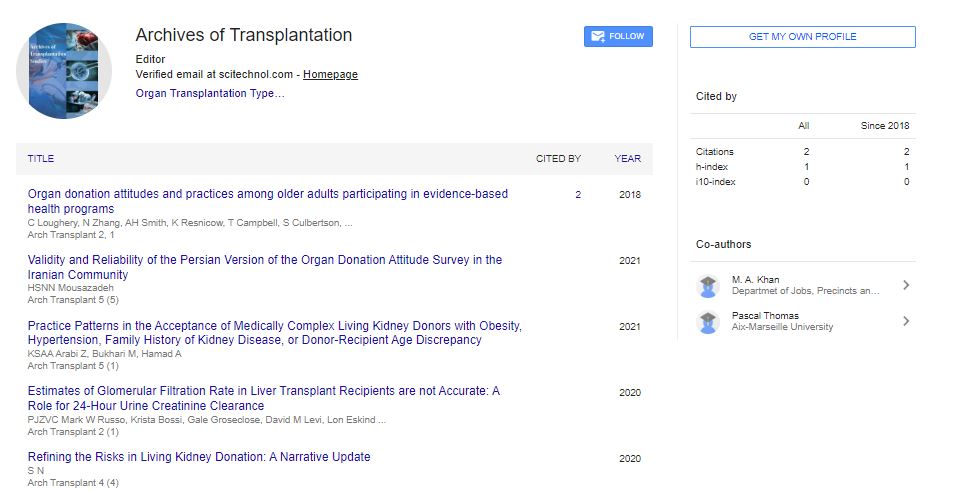Perspective, Arch Transplant Vol: 7 Issue: 4
Enhancing the Mechanisms and Functions of Immunosuppressants in Medicine
Robert Lidier*
1Department of Health Sciences, University of Florence, Florence, Italy
*Corresponding Author: Robert Lidier,
Department of Health Sciences, University
of Florence, Florence, Italy
E-mail: robert_lidier@uf11.it
Received date: 22 November, 2023, Manuscript No. AT-24-124972;
Editor assigned date: 24 November, 2023, PreQC No AT-24-124972 (PQ);
Reviewed date: 11 December, 2023, QC No. AT-24-124972;
Revised date: 19 December, 2023, Manuscript No. AT-24-124972 (R);
Published date: 26 December, 2023, DOI: 10.4172/AT.1000160
Citation: Lidier R (2023) Enhancing the Mechanisms and Functions of Immunosuppressants in Medicine. Arch Transplant 7:4.
Description
Immunosuppressants represent a cornerstone in the field of medicine, particularly in the realm of organ transplantation and autoimmune disorders. These pharmaceutical agents play a pivotal role in modulating the immune system, preventing rejection of transplanted organs, and managing hyperactive immune responses. The intricate mechanisms and evolving functions of immunosuppressant’s, illuminating light on their key role in modern medicine. The immune system serves as the body's defense mechanism, protecting against pathogens, infections, and abnormal cells. However, in the context of organ transplantation, the same immune system that safeguards the body can pose a significant challenge. When a foreign organ is introduced, the immune system recognizes it as a threat and mounts an attack, leading to rejection.
Immunosuppressants act by modulating the immune response at various levels. One primary mechanism involves inhibiting T-cell activation, an essential step in the immune cascade. Calcineurin inhibitors, such as cyclosporine and tacrolimus, disrupt the signaling pathway required for T-cell activation, thereby dampening the immune response. Another class of immunosuppressants, corticosteroids, works by suppressing the activity of immune cells and reducing inflammation. These versatile drugs are used in various medical scenarios, from organ transplantation to managing autoimmune conditions.
Biological agents, such as monoclonal antibodies, target specific components of the immune system. For example, anti-CD25 antibodies inhibit interleukin-2 receptor activation, hindering T-cell proliferation. These targeted approaches allow for precise control over the immune response while minimizing broad immunosuppression.
The primary function of immunosuppressants in organ transplantation is to prevent rejection. After receiving a transplanted organ, the recipient's immune system perceives the graft as foreign tissue and mounts an immune response. Left unchecked, this response can lead to graft rejection, compromising the success of the transplant.
Immunosuppressants, strategically administered in transplant recipients, reduce the immune response, allowing the transplanted organ to integrate successfully. These medications are often used in combination, utilizing their distinct mechanisms to develop a comprehensive immunosuppressive effect. Over the years, advancements in immunosuppressant therapy have focused on enhancing efficacy while minimizing side effects. Novel agents with more targeted mechanisms of action are being developed, aiming to achieve a delicate balance between preventing rejection and preserving overall immune function. Studies is also exploring personalized approaches to immunosuppression, tailoring treatment regimens based on individual patient profiles.
This precision medicine approach seeks to optimize therapeutic outcomes while minimizing the risks associated with long-term immunosuppression. Beyond organ transplantation, immunosuppressant’s plays an key role in managing autoimmune disorders. In conditions like rheumatoid arthritis, lupus, and inflammatory bowel diseases, the immune system mistakenly attacks the body's own tissues.
Immunosuppressive medications help alleviate symptoms and prevent further damage by dampening the hyperactive immune response. While the goal in autoimmune disorders is not to suppress the immune system entirely, finding the right balance is essential. Immunosuppressants provide a means to modulate the immune response, providing relief to individuals grappling with chronic inflammatory conditions. Despite their efficacy, immunosuppressant’s come with challenges. Prolonged use increases the risk of infections and may contribute to long-term complications such as cardiovascular issues, renal impairment, and metabolic disturbances. Striking a balance between preventing rejection and minimizing side effects remains a delicate challenge in the field.
Conclusion
In conclusion, the mechanisms and functions of immunosuppressants in medicine represent a dynamic interplay between science and the intricacies of the immune system. As the understanding of immunology advances, so too does the ability to refine immunosuppressant therapies, providing new hope to organ transplant recipients and individuals battling autoimmune disorders. The ongoing quest to enhance these medications underscores the commitment to achieving optimal outcomes in the delicate balance between immune modulation and preservation of overall health.
 Spanish
Spanish  Chinese
Chinese  Russian
Russian  German
German  French
French  Japanese
Japanese  Portuguese
Portuguese  Hindi
Hindi 